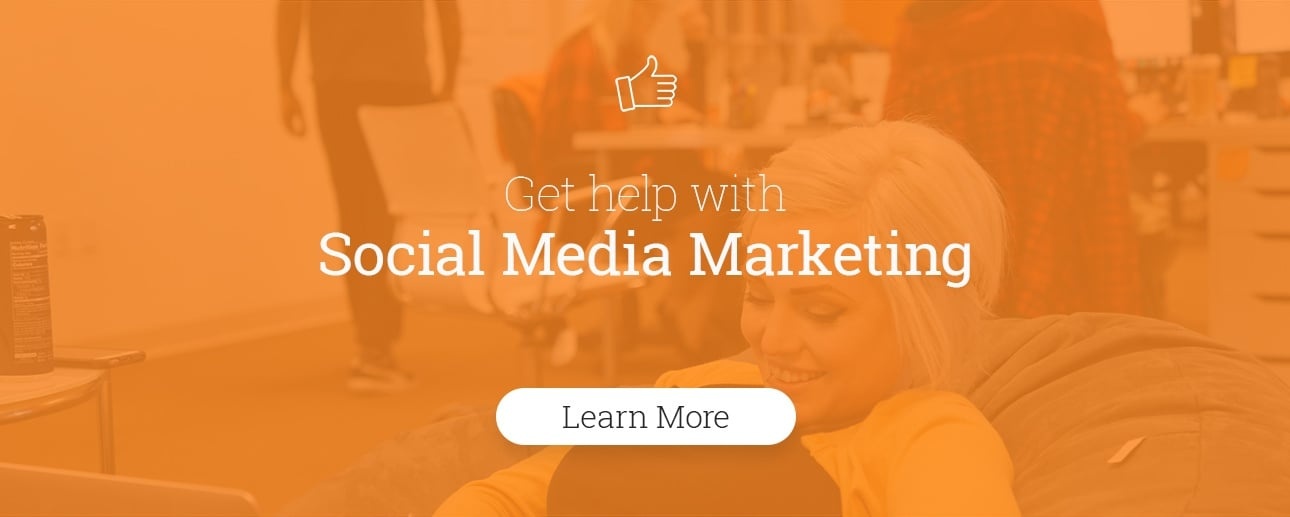As a retired cheerleader, I often have this recurring nightmare where I’m fully put together in my cheer uniform: bow, sneakers, and drag makeup, about to compete in front of thousands of people. I’m standing in formation on stage, sweating my buns off because, in this dream, I never actually learned the routine. Suddenly, the music starts, everyone’s dancing, tumbling and stunting in sync, and there I am, looking as clueless as Gretchen Weiners during the Jingle Bell Rock dance after that last minute formation change. YIKES!

That same feeling happens in real life when you don’t have a social media content plan mapped out. Social media is like running at full speed. Your competitors are consistently posting compelling content, users are commenting and liking posts throughout all hours of the day, and you’re scrambling to find literally any piece of content to post just to keep up with the speed. Again...YIKES! Avoid a social media nightmare by understanding what a great social media content plan should include, using these amazing tips:
A Set Business Goal
When getting started with your social media content plan, you should always start with setting a business goal. HubSpot recommends using S.M.A.R.T. Goals when planning out your social media content strategy. S.M.A.R.T. stands for:
- Specific: What exactly are you trying to achieve? More visits, leads, customers?
- Measurable: Provide numbers and data that you can track along the way.
- Attainable: Make sure your goal is realistic and that you understand the benchmarks.
- Relevant: Relate this back to your overall goal and make sure it’s aligned with your business.
- Timely: Include a timeframe.
To create impactful social media content, it’s important for your content to line up with your business objectives and ambitions. This is what gives your content a purpose. Start by analyzing your social media metrics from the last few months to see where you could use improvements. Then, turn those specific areas into S.M.A.R.T. goals. Those could be anything from increasing brand awareness by getting more users to like and engage with your page and posts, to generating more leads by posting content that links to downloadable offers, etc.

The Appropriate Social Networks
One mistake many businesses make is treating all social media platforms the same. Every social media channel has its own distinctive function, audience and language. Be sure to treat them that way. When developing a social media content plan, it’s extremely important to first consider your audience and the social platforms are they using. Once you’ve identified which social media platforms your target audience is actively using, cater your content to fit each specific channel. Let’s break down some of the top social channels to give a better understand of the type of content you should be creating:
Facebook is the most popular social media platform with over 2 billion users. This is a great platform to attract new visitors, build a community, visually promote your business, acknowledge guest reviews, tell stories, engage with users, and more.
Twitter has 330 million monthly active users. This is a fast-paced app that features constant updates, or “tweets” with 280-character messages. This platform allows users to follow one another and view these tweets on their newsfeed. Since this social platform is so fast-paced, it’s common for businesses to post multiple times a day. This is also a good platform for businesses to acknowledge real-time customer-service tweets from users who mention you in their updates.
With more than 700 million users, Instagram is a visual social sharing app that allows users to share photos, videos, and stories. This is a great platform for businesses to share some of their work, team culture photos and videos, user-generated content (UGC), real-time social stories, and more.
This network of over 500 million business users and more than 9 million business profile pages can be an important resource. LinkedIn is a great platform for businesses to use to draw in potential new team members, share industry related content and network with relevant users.

It’s important to understand how each social platform works and which ones your ideal target audience is using before getting started. Note that it’s unnecessary to be on every single social media platform just for exposure purposes. Think quality over quantity. It’s useless and a waste of time to put effort into a specific social media platform that none of your ideal target audience is using. So take the time to research where the users are who you want to see your message and create content tailored to that platform and those users. This will ensure that your message is put in front of the right people, in the right places, at the right time.
Content Calendar
Once you’ve identified which social media platforms your businesses should be using, it’s best to plan ahead and stay organized with a content calendar. Planning your social media content ahead of time ensures that you consistently have valuable content going up. It also ensures that you don’t miss any important dates or deadlines. The last thing you want to be doing is scrambling for content to post on social media.
When creating your content calendar, you first want to figure out what type of content your ideal customers would enjoy and find helpful. It should also align with the goals you previously set. Create content that users will want to share and engage with. This is where you get to have fun and be creative. It’s also a good idea to check out your existing social media metrics and see what type of content has been performing best, so you know what type of content you should continue to create in order to get the best results.
Next, you’ll want to make sure you’re posting an appropriate amount on each social media channel. Below is a list of the best recommended times to post a day per each social channel, according to Constant Contacts:
- Facebook: 3-10 times a week
- Twitter: 5 times a day
- LinkedIn: 2-5 times a week
Once you’ve decided on the type of content you’d like to share and have a better understanding of the recommended post frequency per platform, you’ll want to organize this information into a structured calendar. There’s several tools and templates you can use to organize your content calendar. Google Docs, Excel and Box.com are just a few of many tools you can use to create a content calendar. These tools allow you to create your own customized social calendar, add personalized crafted posts, times to post, and more. HubSpot offers a free template that’s great for social content planning.

After completing your social media content calendar, it’s always a great idea to get an extra set of eyes on it and ensure there are no spelling, grammatical errors or important missing posts. Once your calendar has been internally proofread and all necessary changes have been made, there are several tools you can use to schedule these posts out ahead of time. HubSpot, Hootsuite and Buffer are a few of several third party platforms that allow you to schedule your crafted content and distributed it to the desired social channel at the custom time and date you set.
Could you imagine having to manually post your social content on every single individual platform every day at a specific time? Yeah, that’s a hard pass. Using a scheduling platform helps to save time, increases productivity and allows you to consistently post content at the best performing times. Efficiency at its finest!
AND, if you’re living under a rock and didn’t hear the news, some third party platforms recently introduced automated Instagram scheduling! Read more about this exciting change here.
SEO Optimization
Social media is a powerful SEO tool that should be properly optimized in order to better your chances of being discoverable. There are two important SEO factors you should consider when creating your social media content plan: keywords and social sharing.

Keywords
If you haven’t done so already, come up with a list of relevant, foundational keywords that resonate with your business, products and/or services. Do your research to see what keywords your target audience is searching for and work those keywords into your social media content. These keywords should be dispersed throughout your social accounts. When appropriate, include these keywords in your photo captions, social bios, hashtags, and more, to help increase visibility.
It’s also important to note that not all keywords should be used across every single social media account. As mentioned previously, not all social media platforms are the same and your motives for using each platform may be different depending on what your goals are. For example, your keywords on LinkedIn may be targeted towards potential new employees if your goal is to grow your business, while the keywords you use on Facebook might be related more towards your products if your goal is to reach potential new customers.
Social Sharing
Creating shareable content is an extremely effective way to boost SEO. The more shares your social media posts receive, the more users will see your message, which will attract new users to your social account, website or link associated to that post. This is a prime example of the word-of-mouth effect that, in turn, helps grow your online audience, drive in new potential customers and improve your Google rankings if enough users link to your content. How do you create shareable content? Keep reading to find out...
Authenticity
One last thing you should definitely include in your social media content plan is authenticity. As mentioned above, shareable content directly impacts your SEO ranking. So how do you create shareable content? Be human! Don’t make it all about you. That turns people away and comes off as spammy. Instead, think about your customers and the type of content they care about. Below are a few helpful tips to help your brand appear authentic:

Video
If you haven’t figured it out yet, video is an extremely effective tool to use when marketing your business. More than 180 million internet users watch online video content every month. That’s a crap ton of people, right? And there’s so many creative ways to use it such as how-to videos, Facebook cover videos, testimonials, behind-the scenes...you name it! Whatever route you decide to take, video is great way to put a face to a brand name in a way that’s human, relatable and engaging.
Social Stories
Social stories, also known as “ephemeral content”, is any type of content that is temporary. These are real-time visuals that can be viewed up to 24 hours and appear on platforms such as Snapchat, Facebook and Instagram. This is an excellent tool to showcase behind the scene experiences and show users that real people actually behind scenes for your brand.
Use Humor and Emotion
When creating your social media content plan, it’s important to use humor and emotion. People want to see content that’s funny, relatable and emotional. Avoid making it all about you and using salesy language. No boring sales post has ever gone viral. So have fun with it and let your personality shine through the content!

In Closing
So there you have it. Social media content plans are key to being efficient and consistent! Don’t pull a Gretchen Weiners when it comes to social media. Apply these tips to your social media content plan and you’ll be on the right track to social success!





